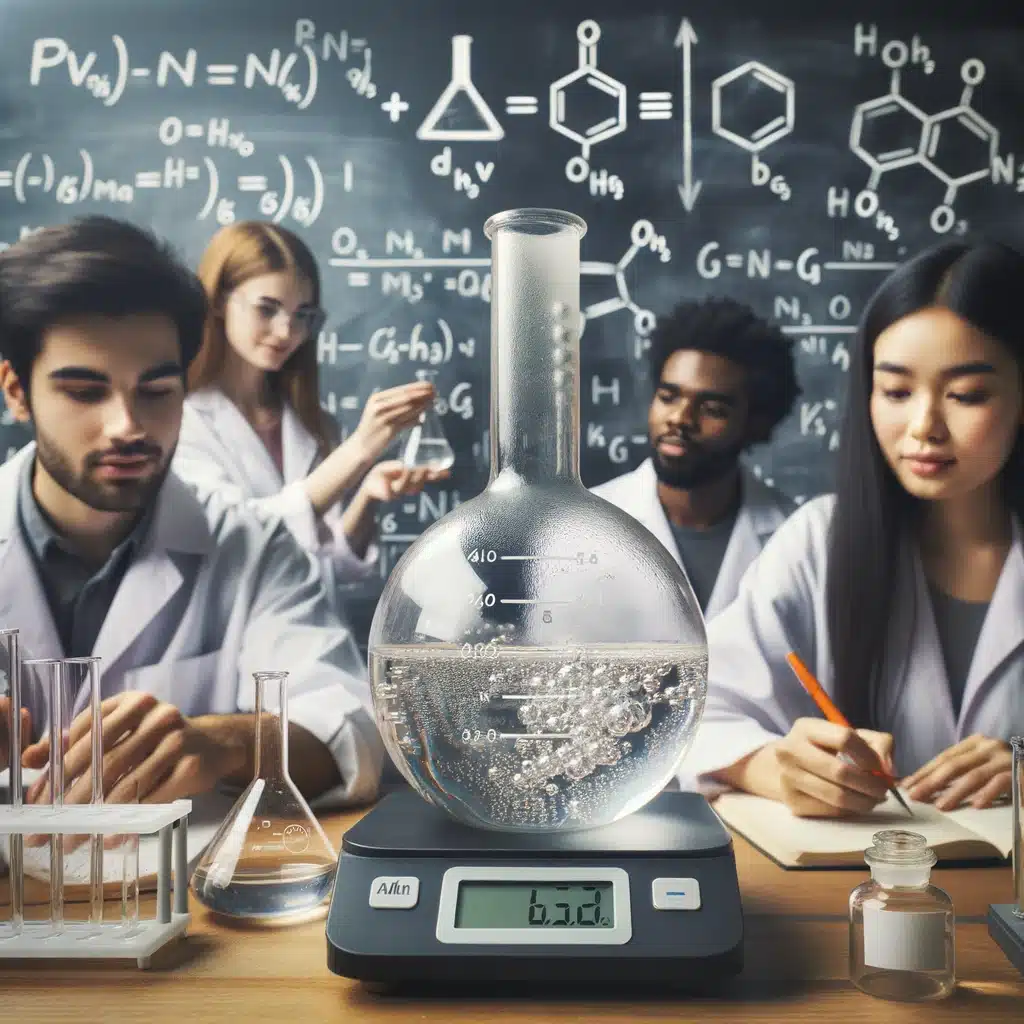Understanding how to find molar mass from volume is a fundamental concept in chemistry. molar mass is defined as the mass of one mole of a substance, and it plays a crucial role in various calculations in chemistry, such as determining the concentration of a solution or the amount of a substance in a given volume. In this blog post, we will explore different methods to find molar mass from volume, including calculations involving temperature, pressure, density, and concentration.
III. How to Find Molar Mass from Volume
A. Step-by-Step Guide to Calculate Molar Mass from Volume

To calculate the molar mass from volume, follow these steps:
- Determine the volume of the substance in question. Make sure the volume is measured in a consistent unit, such as liters (L) or milliliters (mL).
- Convert the volume to the molar volume at standard temperature and pressure (STP). The molar volume at STP is approximately 22.4 liters per mole.
- Divide the given volume by the molar volume to obtain the number of moles.
- Finally, divide the mass of the substance by the number of moles to find the molar mass.
B. Worked Out Examples of Finding Molar Mass from Volume
Let’s work through a couple of examples to solidify our understanding.
Example 1: Find the molar mass of a gas with a volume of 44.8 liters at STP.
Solution:
- Step 1: The given volume is 44.8 liters.
- Step 2: Since the volume is at STP, we can directly use the molar volume of 22.4 liters/mol.
- Step 3: number of moles = 44.8 L / 22.4 L/mol = 2 moles
- Step 4: Divide the mass of the substance by the number of moles to find the molar mass. (This Step requires additional information, such as the mass of the substance.)
Example 2: A sample of gas occupies a volume of 5.60 liters at a pressure of 2.50 atmospheres and a temperature of 300 Kelvin. Find the molar mass of the gas.
Solution:
- Step 1: The given volume is 5.60 liters.
- Step 2: Since the volume is not at STP, we need to use the ideal gas law to calculate the molar mass.
- Step 3: From the ideal gas law equation: PV = nRT, we can rearrange it to solve for n (number of moles). n = PV / RT
- Step 4: Insert the values into the equation: n = (2.50 atm * 5.60 L) / (0.0821 atm L/mol K * 300 K) ≈ 0.481 mol
- Step 5: Divide the mass of the substance by the number of moles to find the molar mass. (This Step requires additional information, such as the mass of the substance.)
IV. How to Find Molar Mass with Volume, Temperature, and Pressure

A. The Ideal Gas Law and its Application
The ideal gas law, PV = nRT, relates the pressure, volume, temperature, and the number of moles of a gas. It is a useful tool for finding the molar mass when more than just the volume is known.
B. Step-by-Step Guide to Calculate Molar Mass with Volume, Temperature, and Pressure
To calculate the molar mass using the ideal gas law, follow these steps:
- Determine the volume, temperature, and pressure of the gas.
- Convert the temperature to Kelvin by adding 273.15 to the Celsius value.
- Convert the pressure to atmospheres if it is not already in that unit.
- Use the ideal gas law equation PV = nRT to calculate the number of moles of the gas.
- Finally, divide the mass of the substance by the number of moles to find the molar mass.
C. Worked Out Examples of Finding Molar Mass with Volume, Temperature, and Pressure
Let’s work through an example to illustrate this concept.
Example: A gas occupies a volume of 10.0 liters at a temperature of 25 degrees Celsius and a pressure of 4.00 atmospheres. Find the molar mass of the gas.
Solution:
- Step 1: The given volume is 10.0 liters, temperature is 25 degrees Celsius (298K), and pressure is 4.00 atmospheres.
- Step 2: Convert the temperature to Kelvin: 25 degrees Celsius + 273.15 = 298K.
- Step 3: The pressure is already in atmospheres.
- Step 4: Use the ideal gas law equation PV = nRT to calculate the number of moles. Rearranging the equation, we have n = PV / RT.
- Step 5: Insert the values into the equation: n = (4.00 atm * 10.0 L) / (0.0821 atm L/mol K * 298 K) ≈ 1.36 mol.
- Step 6: Divide the mass of the substance by the number of moles to find the molar mass. (This Step requires additional information, such as the mass of the substance.)
How to Calculate Mass from Volume and Concentration
A. Understanding Concentration in Chemistry
concentration is a measure of the amount of solute dissolved in a given amount of solvent or solution. It is vital in many areas of chemistry, such as preparing solutions and determining stoichiometry. Molar concentration, also known as molarity, is the most common way to express concentration, and it is defined as the number of moles of solute per liter of solution.
B. Step-by-Step Guide to Calculate Mass from Volume and Concentration
To calculate the mass from volume and concentration, follow these steps:
- Determine the volume of the solution and the molar concentration.
- Convert the volume to liters if it is not already in that unit.
- Multiply the volume by the molar concentration to obtain the number of moles of solute.
- Finally, multiply the number of moles by the molar mass to find the mass of the solute.
C. Worked Out Examples of Calculating Mass from Volume and Concentration
Let’s work through an example to illustrate this concept.
Example: What is the mass of the solute in a 500 mL solution with a molar concentration of 0.25 M?
Solution:
- Step 1: The given volume is 500 mL, and the molar concentration is 0.25 M.
- Step 2: Convert the volume to liters: 500 mL / 1000 mL/L = 0.5 L.
- Step 3: Multiply the volume by the molar concentration: 0.5 L * 0.25 mol/L = 0.125 mol.
- Step 4: Multiply the number of moles by the molar mass to find the mass of the solute. (This Step requires additional information, such as the molar mass of the solute.)
VI. How to Find Molar Mass from Density and Volume
A. Understanding Density in Chemistry
Density is a measure of how much mass is contained in a given volume. It is often used to identify substances or determine the concentration of a solution. In the context of finding molar mass, density can be a useful parameter when combined with volume.
B. Step-by-Step Guide to Calculate Molar Mass from Density and Volume
To calculate the molar mass from density and volume, follow these steps:
- Determine the density and volume of the substance.
- Convert the density to grams per liter (g/L) if it is not already in that unit.
- Multiply the density by the volume to obtain the mass of the substance.
- Finally, divide the mass by the molar mass to find the number of moles, and hence, the molar mass.
C. Worked Out Examples of Finding Molar Mass from Density and Volume
Let’s work through an example to illustrate this concept.
Example: A liquid has a density of 1.50 g/mL and occupies a volume of 250 mL. Find the molar mass of the liquid.
Solution:
- Step 1: The given density is 1.50 g/mL, and the volume is 250 mL.
- Step 2: Convert the density to grams per liter: 1.50 g/mL * 1000 mL/L = 1500 g/L.
- Step 3: Multiply the density by the volume: 1500 g/L * 250 mL = 375000 g.
- Step 4: Divide the mass by the molar mass to find the number of moles and the molar mass. (This Step requires additional information, such as the mass of the substance.)
VII. How to Find Concentration from Molar Mass and Volume
A. Understanding the Relationship between Concentration, Molar Mass, and Volume
The concentration of a solution is directly related to the molar mass and volume of the solute. By knowing the molar mass and volume, we can calculate the concentration of a solution.
B. Step-by-Step Guide to Find Concentration from Molar Mass and Volume
To find the concentration from molar mass and volume, follow these steps:
- Determine the molar mass of the solute and the volume of the solution.
- Convert the volume to liters if it is not already in that unit.
- Divide the molar mass by the volume to obtain the concentration in moles per liter (M).
C. Worked Out Examples of Finding Concentration from Molar Mass and Volume
Let’s work through an example to illustrate this concept.
Example: A solution contains 0.50 moles of solute dissolved in 2.0 liters of solution. Find the concentration of the solution.
Solution:
- Step 1: The molar mass of the solute is not given, but we know the number of moles.
- Step 2: The volume is already in liters.
- Step 3: Divide the number of moles by the volume: 0.50 mol / 2.0 L = 0.25 M.
Also Read:
- How to find final velocity
- How to find gravitational acceleration
- How to find constant acceleration with distance and time
- How to find the amplitude of a wave
- How to find angular acceleration from angular velocity
- How to find acceleration with velocity and distance
- How to find average velocity on a acceleration time graph
- How to find final velocity without acceleration
- How to find molar mass from molarity
- How to find mass without acceleration

Hello,
I am Aditi Ray, a chemistry SME on this platform. I have completed graduation in Chemistry from the University of Calcutta and post graduation from Techno India University with a specialization in Inorganic Chemistry. I am very happy to be a part of the Lambdageeks family and I would like to explain the subject in a simplistic way.
Let’s connect through LinkedIn-https://www.linkedin.com/in/aditi-ray-a7a946202